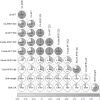Correlations of Aflatoxin Exposure from Cooking Oil and Dietary Foods During Pregnancy with Birth Weight and Gestational Age at Birth in Guangxi, China
- PMID: 38562209
- PMCID: PMC10982453
- DOI: 10.2147/IJGM.S453839
Correlations of Aflatoxin Exposure from Cooking Oil and Dietary Foods During Pregnancy with Birth Weight and Gestational Age at Birth in Guangxi, China
Abstract
Background: Cooking oil and dietary foods are easily contaminated by aflatoxins (AFs) in Guangxi, China where low birth weight and preterm birth were prevalent. However, there are no data on AF exposure in pregnant women or their impact on newborn birth outcomes. This study aims to measure the levels and correlations of AFs in cooking oil, estimated dietary intake (EDI) of AFs in dietary foods, and serum AFB1 albumin adducts (AFB1-alb) with newborn birthweight and gestational age at birth.
Methods: A prospective study was conducted among 126 pregnant women in Guangxi, China. All recruited women were interviewed for demographic data and behavior and obstetric information and then followed up until giving birth. AF measurements were obtained from cooking oil, dietary foods, maternal serum, and cord blood and the correlations of AF levels with newborn birthweight and gestational age at birth were tested using correlation analysis.
Results: The median EDI of AFs in cooking oil was 2.61 ng/kg.bw/day and in dietary foods 2.95 ng/kg.bw/day. High positive correlations among EDI of aflatoxin B1 (AFB1) from cooking oil and dietary foods were found (r > 0.7). Low positive correlations of AFB1-alb in maternal serum and cord blood and both EDI of AFB1 in both cooking oil and dietary foods were shown (r ≈0.3). Significant correlations between AF levels in both cooking oil and dietary foods with birth weight were found, but very low negative correlations (r = - 0.244 ~ -0.285). AFB1 levels in foods, maternal serum and cord blood levels were high in pregnant women with newborn low birth weight and preterm birth.
Conclusion: The EDIs of AFB1 from both cooking oil and dietary foods were significantly correlated with AFB1-alb in maternal serum and cord blood. Negative correlations of AFs from cooking oils and foods with newborn birth weight should be paid more attention.
Keywords: AFB1 albumin adducts; EDI; aflatoxins; birthweight; gestational age at birth.
© 2024 Zhong et al.
Conflict of interest statement
The authors declare that they have no competing financial interests or personal relationships that could have influenced this paper, and all of them have agreed to submit the manuscript to this journal.
Figures



Similar articles
-
Associations between Serum Aflatoxin-B1 and Anemia in Pregnant Women: Evidence from Guangxi Zhuang Birth Cohort in China.Toxins (Basel). 2021 Nov 15;13(11):806. doi: 10.3390/toxins13110806. Toxins (Basel). 2021. PMID: 34822590 Free PMC article.
-
Risk Assessment of Hepatocellular Carcinoma with Aflatoxin B1 Exposure in Edible Oils.Toxins (Basel). 2022 Aug 11;14(8):547. doi: 10.3390/toxins14080547. Toxins (Basel). 2022. PMID: 36006209 Free PMC article.
-
Relatively Low Maternal Aflatoxin Exposure Is Associated with Small-for-Gestational-Age but Not with Other Birth Outcomes in a Prospective Birth Cohort Study of Nepalese Infants.J Nutr. 2019 Oct 1;149(10):1818-1825. doi: 10.1093/jn/nxz122. J Nutr. 2019. PMID: 31198947
-
The mediating role of coagulation function on the association of prenatal exposure to aflatoxin B1 and postpartum hemorrhage in Guangxi, China.Environ Sci Pollut Res Int. 2022 May;29(25):37543-37555. doi: 10.1007/s11356-021-18186-8. Epub 2022 Jan 23. Environ Sci Pollut Res Int. 2022. PMID: 35066843
-
Omega-3 Fatty Acids and Maternal and Child Health: An Updated Systematic Review.Evid Rep Technol Assess (Full Rep). 2016 Oct;(224):1-826. doi: 10.23970/AHRQEPCERTA224. Evid Rep Technol Assess (Full Rep). 2016. PMID: 30307735
References
LinkOut - more resources
Full Text Sources
Miscellaneous

